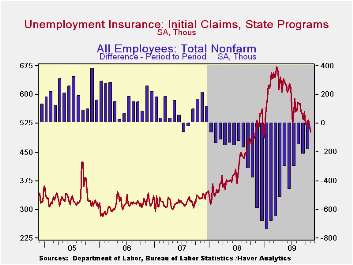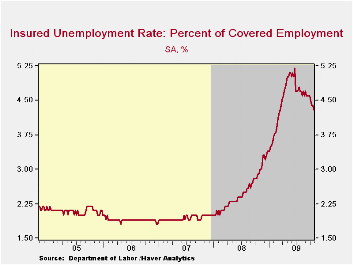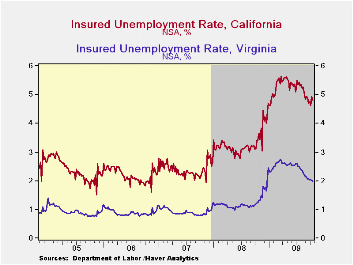 Global| Nov 12 2009
Global| Nov 12 2009U.S. Weekly Initial Jobless Insurance Claims Fall Again To 2009 Low
by:Tom Moeller
|in:Economy in Brief
Summary
U.S. job market continues to improve. That's the message from the Labor Department's report of another decline last week in initial claims for jobless insurance. They're down to 502,000 from 514,000 during the prior week which was [...]
 U.S. job
market continues to improve. That's the message from the Labor
Department's report of another decline last week in initial claims for
jobless insurance. They're down to 502,000 from 514,000 during the
prior week which was revised up from 512,000. The latest figures are
the lowest of this year and are down sharply from the March peak of
674,000 claims. The four-week moving average of claims fell to 519,750
and the latest weekly figure was lower than Consensus expectations for
510,000.
U.S. job
market continues to improve. That's the message from the Labor
Department's report of another decline last week in initial claims for
jobless insurance. They're down to 502,000 from 514,000 during the
prior week which was revised up from 512,000. The latest figures are
the lowest of this year and are down sharply from the March peak of
674,000 claims. The four-week moving average of claims fell to 519,750
and the latest weekly figure was lower than Consensus expectations for
510,000.
 Continuing claims for unemployment insurance during the
latest week fell a sharp 139,000 to the lowest level since mid-March.
The decline reflects the improved job market but may also be a function
of the exhaustion of benefits. Continuing claims provide an indication
of workers' ability to find employment. The four-week average of
continuing claims fell modestly to 5,790,750 and have fallen 14.5% from
their peak. This series dates back to 1966. Extended benefits
for unemployment insurance fell and reversed the prior week's increase.
Through late-October extended benefits averaged 523,061.
Continuing claims for unemployment insurance during the
latest week fell a sharp 139,000 to the lowest level since mid-March.
The decline reflects the improved job market but may also be a function
of the exhaustion of benefits. Continuing claims provide an indication
of workers' ability to find employment. The four-week average of
continuing claims fell modestly to 5,790,750 and have fallen 14.5% from
their peak. This series dates back to 1966. Extended benefits
for unemployment insurance fell and reversed the prior week's increase.
Through late-October extended benefits averaged 523,061.
The insured rate of unemployment slipped 4.3%, the lowest since mid-March. The rate reached a high of 5.2% during late-June. During the last ten years, there has been a 93% correlation between the level of the insured unemployment rate and the overall rate of unemployment published by the Bureau of Labor Statistics.
 The highest insured unemployment
rates in the week ending October 24 were in Puerto Rico (6.4%), Oregon
(5.4), Nevada (5.2), Pennsylvania (4.9), California (4.8), Arkansas
(4.8), Wisconsin (4.8), Alaska (4.8), Michigan (4.5), North Carolina
(4.5), and South Carolina (4.5). The lowest insured unemployment rates
were in North Dakota (1.1%), South Dakota (1.1), Virginia (2.0),
Wyoming (2.6), Maine (2.5), Texas (2.5), Colorado (2.9), Maryland
(3.2), Mississippi (3.5), New York (3.5), Georgia (3.7) and Florida
(3.8).
The highest insured unemployment
rates in the week ending October 24 were in Puerto Rico (6.4%), Oregon
(5.4), Nevada (5.2), Pennsylvania (4.9), California (4.8), Arkansas
(4.8), Wisconsin (4.8), Alaska (4.8), Michigan (4.5), North Carolina
(4.5), and South Carolina (4.5). The lowest insured unemployment rates
were in North Dakota (1.1%), South Dakota (1.1), Virginia (2.0),
Wyoming (2.6), Maine (2.5), Texas (2.5), Colorado (2.9), Maryland
(3.2), Mississippi (3.5), New York (3.5), Georgia (3.7) and Florida
(3.8).
The unemployment insurance claims data is available in Haver's WEEKLY database and the state data is in the REGIONW database.
The Exchange Rate: What's in It for Prices? from the Federal Reserve Bank of Philadelphia is available here.
| Unemployment Insurance (000s) | 11/07/09 | 10/31/09 | 10/24/09 | Y/Y | 2008 | 2007 | 2006 |
|---|---|---|---|---|---|---|---|
| Initial Claims | 502 | 514 | 532 | -1.4% | 420 | 321 | 313 |
| Continuing Claims | -- | 5,631 | 5,770 | 43.2% | 3,342 | 2,552 | 2,459 |
| Insured Unemployment Rate (%) | -- | 4.3 | 4.4 | 3.1 (11/'08) | 2.5 | 1.9 | 1.9 |
Tom Moeller
AuthorMore in Author Profile »Prior to joining Haver Analytics in 2000, Mr. Moeller worked as the Economist at Chancellor Capital Management from 1985 to 1999. There, he developed comprehensive economic forecasts and interpreted economic data for equity and fixed income portfolio managers. Also at Chancellor, Mr. Moeller worked as an equity analyst and was responsible for researching and rating companies in the economically sensitive automobile and housing industries for investment in Chancellor’s equity portfolio. Prior to joining Chancellor, Mr. Moeller was an Economist at Citibank from 1979 to 1984. He also analyzed pricing behavior in the metals industry for the Council on Wage and Price Stability in Washington, D.C. In 1999, Mr. Moeller received the award for most accurate forecast from the Forecasters' Club of New York. From 1990 to 1992 he was President of the New York Association for Business Economists. Mr. Moeller earned an M.B.A. in Finance from Fordham University, where he graduated in 1987. He holds a Bachelor of Arts in Economics from George Washington University.






